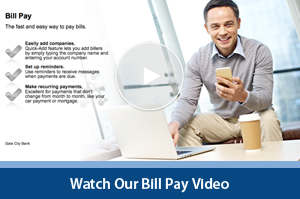Payments can be made manually or automatically:
1. Automatic payment in response to an e-bill:
An automatic payment in response to an e-bill is a payment that you set up to go out every time you receive this e-bill without requiring your approval each time. You can pay the full bill, pay the minimum due, pay nothing and file the bill, or create your own rule for how the bill gets paid. For example, you could tell us to pay your credit card bill automatically in three different ways:
- Pay the entire bill if it is $200 or less. Pay nothing and send an e-mail notification if it is more than $200.
- Pay the minimum amount due every month.
- Pay nothing and send an e-mail notification.
You can also select when to pay the bill-either when the bill arrives or a designated number of days before the bill is due (10 is the default). You will receive an e-mail notification when an automatic bill has been paid.
2. Automatic payment at regular intervals:
This type of automatic payment gets paid by establishing the interval when the payment should be made, along with the supporting payment details. You specify the amount, the frequency, the start date and the end date or the number of payments to make (for due date models it is number of payments instead of end date). Based on the duration of the loan you could also establish the end date of the automatic payment rule. For example, you could have us schedule a payment for your car loan in the amount of $300 on the 1st of every month for the next 36 months.
3. Manual payment:
This rule means that you do not wish to set up an automatic payment. Instead, you would manually issue a payment every time we receive one of your bills or when your bill is due. This is the default payment rule for each payee you add.



